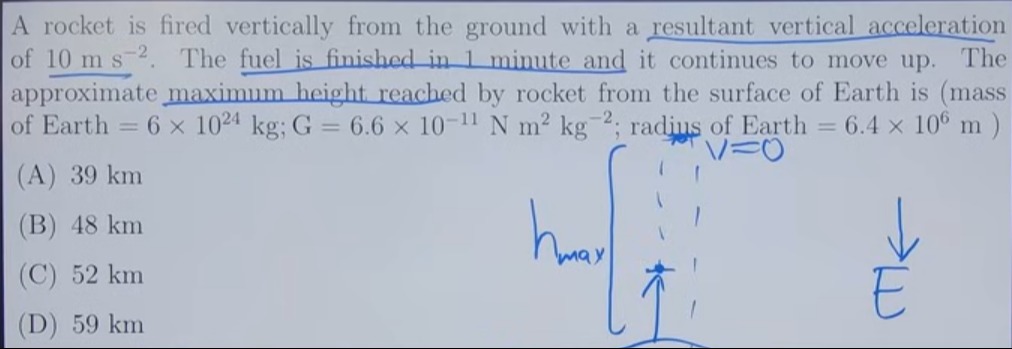Question
Question: A rocket is fired vertically from the ground with a resultant vertical acceleration of 10 m s$^{-2}$...
A rocket is fired vertically from the ground with a resultant vertical acceleration of 10 m s−2. The fuel is finished in 1 minute and it continues to move up. The approximate maximum height reached by rocket from the surface of Earth is (mass of Earth = 6 × 1024 kg; G = 6.6 × 10−11 N m2 kg−2; radius of Earth = 6.4 × 106 m)

39 km
48 km
52 km
59 km
39 km
Solution
The problem asks for the approximate maximum height reached by a rocket fired vertically from the ground. The motion can be divided into two phases:
Phase 1: Accelerated motion (fuel burning)
The rocket starts from rest (u1=0) with a resultant vertical acceleration (a=10m s−2) for a duration of t=1minute=60s.
-
Height covered in Phase 1 (h1): Using the kinematic equation h1=u1t+21at2: h1=(0)(60)+21(10m s−2)(60s)2 h1=21(10)(3600) h1=5×3600=18000m=18km
-
Velocity at the end of Phase 1 (v1): Using the kinematic equation v1=u1+at: v1=0+(10m s−2)(60s) v1=600m s−1
Phase 2: Motion under gravity (fuel exhausted)
After 1 minute, the fuel is finished, and the rocket continues to move upwards under the influence of Earth's gravity. The initial velocity for this phase is v1=600m s−1 from a height h1=18km above the ground. The rocket will reach its maximum height when its final velocity becomes zero.
Since the height reached is relatively small compared to the Earth's radius (RE=6.4×106m=6400km), we can approximate the acceleration due to gravity (g) as constant (g≈9.8m s−2). The problem asks for an "approximate" height, which supports this assumption.
-
Additional height covered in Phase 2 (h2): Using the kinematic equation vf2=vi2−2gh2, where vf=0 (at maximum height) and vi=v1: 02=v12−2gh2 h2=2gv12 Using g=9.8m s−2: h2=2×9.8m s−2(600m s−1)2=19.6360000 h2≈18367.35m≈18.37km
-
Total maximum height (Hmax): The maximum height reached from the surface of Earth is the sum of the heights from both phases: Hmax=h1+h2 Hmax=18km+18.37km Hmax=36.37km
This value is approximately 36km. Looking at the options, 39km is the closest. The difference might be due to rounding g to 10m s−2 or other approximations.
Let's check with g=10m s−2 for the second phase, as sometimes done in problems with round numbers: h2=2×10m s−2(600m s−1)2=20360000=18000m=18km In this case, Hmax=18km+18km=36km.
The given options are quite spaced out. The closest option is 39 km. The small difference could be attributed to using a slightly different value for g (e.g., if the problem implicitly assumes g is slightly less than 9.8 or 10, or if the "approximate" nature allows for some deviation). However, using the provided values for G, M_E, R_E, we can calculate g0=RE2GME=(6.4×106)26.6×10−11×6×1024=40.96×101239.6×1013=40.96396≈9.667m s−2. If we use g=9.667m s−2: h2=2×9.667360000=19.334360000≈18629m≈18.63km Hmax=18km+18.63km=36.63km.
All constant g approximations lead to a value around 36-37 km. The closest option is 39 km. It's possible the exact value of g or the "approximate" nature of the question allows for this difference.
Let's consider the energy conservation approach to see if it yields a significantly different answer, although for these heights, constant g is usually a good approximation. Initial total energy (at RE+h1 with velocity v1): Ei=21mv12−RE+h1GMEm Final total energy (at RE+Hmax with velocity 0): Ef=−RE+HmaxGMEm Equating Ei=Ef: 21v12−RE+h1GME=−RE+HmaxGME RE+Hmax1=RE+h11−2GMEv12 RE+h1=6.4×106+18000=6.418×106m GME=6.6×10−11×6×1024=39.6×1013N m2kg−1 2GMEv12=2×39.6×1013(600)2=79.2×10133.6×105=79.23.6×10−8=0.04545×10−8=4.545×10−10 RE+h11=6.418×1061≈0.1558×10−6 RE+Hmax1=0.1558×10−6−0.0004545×10−6=(0.1558−0.0004545)×10−6=0.1553455×10−6 RE+Hmax=0.1553455×10−61≈6.437×106m Hmax=(6.437×106m)−(6.4×106m)=0.037×106m=37km.
The energy conservation method gives approximately 37km. This is still closest to 39km. The small difference might be due to the "approximate" nature of the question or slight rounding in the options.
The most precise calculation (using energy conservation and given constants) gives 37km. Given the options, 39km is the most reasonable approximate answer.
